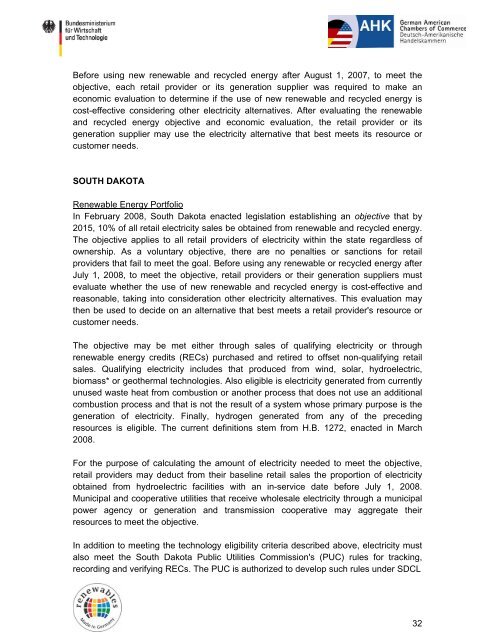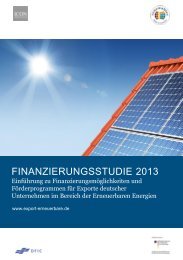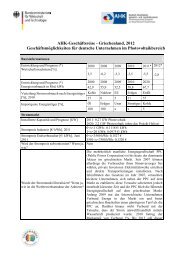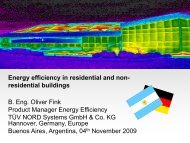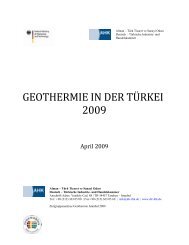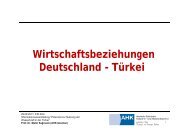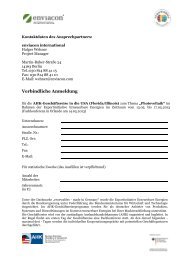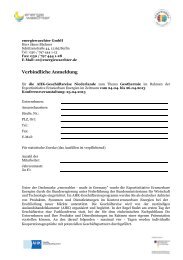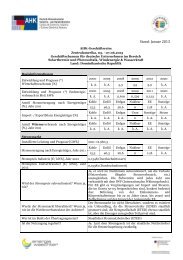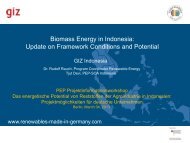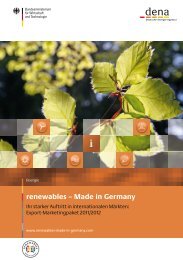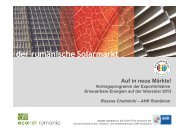PDF: 1,1 MB - Exportinitiative Erneuerbare Energien
PDF: 1,1 MB - Exportinitiative Erneuerbare Energien
PDF: 1,1 MB - Exportinitiative Erneuerbare Energien
- No tags were found...
You also want an ePaper? Increase the reach of your titles
YUMPU automatically turns print PDFs into web optimized ePapers that Google loves.
Before using new renewable and recycled energy after August 1, 2007, to meet the<br />
objective, each retail provider or its generation supplier was required to make an<br />
economic evaluation to determine if the use of new renewable and recycled energy is<br />
cost-effective considering other electricity alternatives. After evaluating the renewable<br />
and recycled energy objective and economic evaluation, the retail provider or its<br />
generation supplier may use the electricity alternative that best meets its resource or<br />
customer needs.<br />
SOUTH DAKOTA<br />
Renewable Energy Portfolio<br />
In February 2008, South Dakota enacted legislation establishing an objective that by<br />
2015, 10% of all retail electricity sales be obtained from renewable and recycled energy.<br />
The objective applies to all retail providers of electricity within the state regardless of<br />
ownership. As a voluntary objective, there are no penalties or sanctions for retail<br />
providers that fail to meet the goal. Before using any renewable or recycled energy after<br />
July 1, 2008, to meet the objective, retail providers or their generation suppliers must<br />
evaluate whether the use of new renewable and recycled energy is cost-effective and<br />
reasonable, taking into consideration other electricity alternatives. This evaluation may<br />
then be used to decide on an alternative that best meets a retail provider's resource or<br />
customer needs.<br />
The objective may be met either through sales of qualifying electricity or through<br />
renewable energy credits (RECs) purchased and retired to offset non-qualifying retail<br />
sales. Qualifying electricity includes that produced from wind, solar, hydroelectric,<br />
biomass* or geothermal technologies. Also eligible is electricity generated from currently<br />
unused waste heat from combustion or another process that does not use an additional<br />
combustion process and that is not the result of a system whose primary purpose is the<br />
generation of electricity. Finally, hydrogen generated from any of the preceding<br />
resources is eligible. The current definitions stem from H.B. 1272, enacted in March<br />
2008.<br />
For the purpose of calculating the amount of electricity needed to meet the objective,<br />
retail providers may deduct from their baseline retail sales the proportion of electricity<br />
obtained from hydroelectric facilities with an in-service date before July 1, 2008.<br />
Municipal and cooperative utilities that receive wholesale electricity through a municipal<br />
power agency or generation and transmission cooperative may aggregate their<br />
resources to meet the objective.<br />
In addition to meeting the technology eligibility criteria described above, electricity must<br />
also meet the South Dakota Public Utilities Commission's (PUC) rules for tracking,<br />
recording and verifying RECs. The PUC is authorized to develop such rules under SDCL<br />
32


